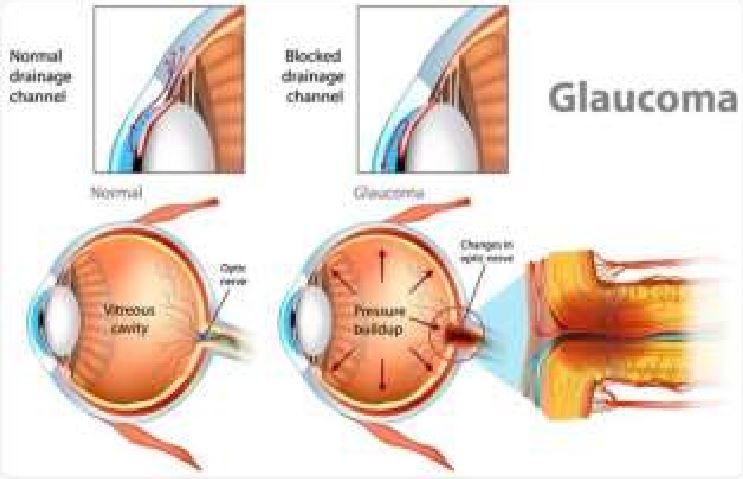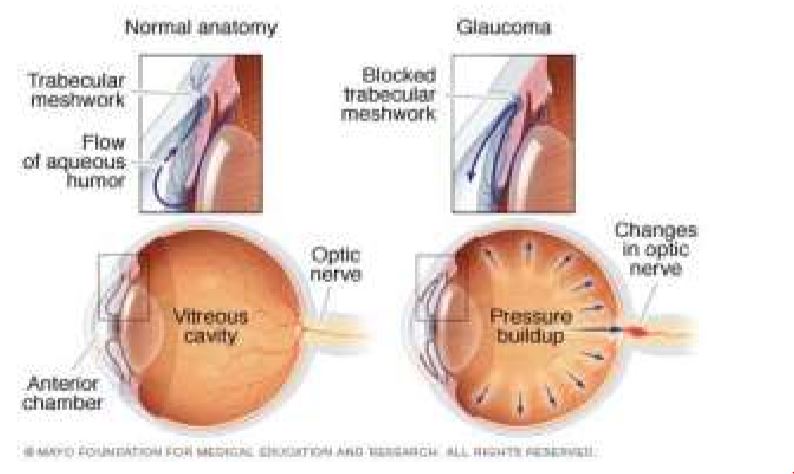Advanced Glaucoma Surgery Hospital in Punjab (India)
People with Glaucoma have optic nerve damage from fluid buildup in their eye. Left untreated, this eye pressure can permanently affect vision. Glaucoma is the second leading cause of blindness in the world. Glaucoma is a general term used to describe a group of eye disorders that damage your optic nerve. In most cases flued builds up in the front part of your eye. This extra fluid. Puts pressure on your eye. Gradually damaging your optic nerve. The name of the pressure is intra ocular pressure.(IOP) or eye pressure untreated glaucoma or poorly managed glaucoma can lead to permanent and irreversible vision loss and blindness. Most people develop glaucoma in both eyes, although the disease initially way worse in one eye.

Open Angle Glaucoma: With open angle glaucoma one eye have moderate or severe damage while the other eye may be mildly affected open angle glaucoma is the most common affecting up to 90% people who have glaucoma in Americans. It occurs when resistances builds up in your eyes damage canals Over months or years the fluid in your eye can buildup put pressure on your optic nerve. The disease may go unnoticed for years because most people didn’t have symptoms.
Closed Angle Glaucoma: Also called closure or narrow angle glaucoma this rare type after comes suddenly (acute). It occurs when the angle between your iris and cornea is too narrow. Your pupil changes and becomes too big (dilated) too quickly. This blocks your drainage canals & prevents aqueous fluid from leaving your eye. Causing eye pressure to rise symptoms include eye pain headache can be severe and requires medical attention quickly.

Symptoms
- Eye Pain
- Eye Pressure
- Headaches
- Rainbow colored halos around light
- Blurred vision
- Nausea or vomiting
Risk Factors:
People with diabetes are twice as likely to get glaucoma other risk factors include:-
1. Family history of glaucoma.
2. Farsightedness or hyperopia (for closed angle glaucoma)
3. High and low blood pressure.
4. Long term of steroids.
How is Glaucoma Diagnosed?
Its possible to have glaucoma and not know it. Regular eye exams are important to catch glaucoma or other eye problems.
To Check Glaucoma:-
- Dilated eye exam to widen pupil and view your optic nerve at the back of your eyes.
- Gonioscopy to examine the angle where your iris and cornea meet.
- OCT (Optical Coherence Tomography) to look for changes in your optic nerve that my indicate glaucoma.
- Ocular pressure test (Tonometry) To measure eye pressure.
- Pachymetry to measure corneal thickness.
- Visual acuity test (eye chart) to check for vision loss.
-
Perimetry to check for changes in peripheral vision.
(your ability to see things off to the side).

How is glaucoma Treated ?
❖ Medications: Many types of prescriptions eye drops can treat glaucoma some decrease fluids and increase drainage to improve eye pressure. Because glaucoma is a lifelong condition you need to use daily eye drops for life.
❖ Carbonic & Anhydrace Inhibitors reduce eye pressure by decreasing the producing the production of intraocular fluid. These are available as eye drops.
1. Dorzolamide
2. Brimzolamide.
3. As well as pills namely Diamox, Acetazolamide, Neptazane, Methazolamide.
Laser Therapy to Treat Glaucoma:
Your eye doctor uses laser (a strong beam of light) to help improve fluid drainage from your eye. Have laser treatment may not replace the use of eye drops completely. The results from laser treatments vary but can last for years in some cases. Your provider may be able to repeat some types of laser treatments.
❖ Surgery: Surgery is another way to help reduce eye pressure. Its more invasive but can also achieve better eye pressure control faster than drops or laser’s. Surgery can help slow down vision loss, but it can’t restore lost vision or cure glaucoma. There are many types of surgeries for glaucoma and depending on the specific type and severity, your doctor may choose one over another.
❖ The most common type of surgery for glaucoma is called TRABE (Trabeculectomy), it involves removing part of the eye drainage tubes to allow fluid to drain more easily.

- Medications, in the form of eye drops or pills, lower pressure by reducing the amount of fluid produced in the eye, and by increasing drainage. One or more medicines may be used at the same time.
- Laser therapy, performed on an outpatient basis, is used to reduce pressure in the eye. A procedure called laser trabeculoplasty improves fluid drainage in patients with open-angle glaucoma. People with closed-angle glaucoma usually must be treated with a procedure called laser iridotomy, which creates a tiny opening in the iris (colored part of the eye), allowing the drainage angle to open.
- Glaucoma Surgery may be needed to create a second drainage channel in the eye to support the natural one. Glaucoma surgery is usually performed on an outpatient basis using local anesthesia and may allow the patient to reduce or eliminate glaucoma medications.
- For more advanced cases, an artificial glaucoma drainage implant may help to decrease pressure. The implant helps to drain excess fluid, which is then absorbed into the body.


